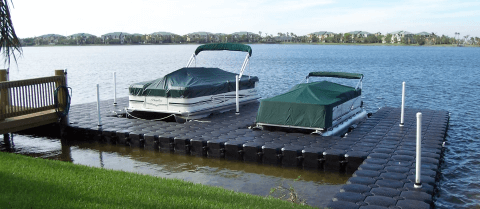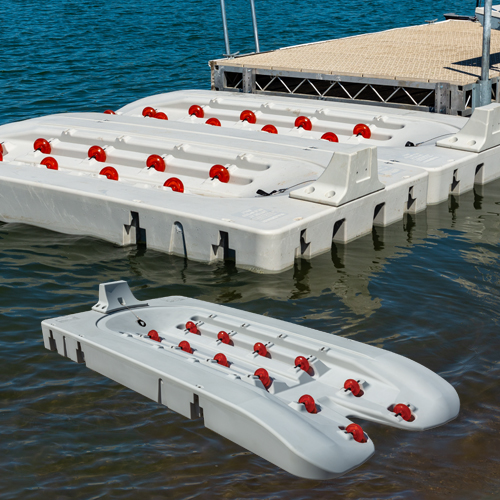Browsing the Options: Choosing the Right Dock Company for Your Floating Dock Project
Browsing the Options: Choosing the Right Dock Company for Your Floating Dock Project
Blog Article
Create the Perfect Docking Service With Floating Docks
Floating docks present a flexible solution for a range of maritime requirements, adjusting perfectly to rising and fall water degrees and diverse vessel kinds. As we check out the vital elements that add to the efficiency of floating docks, a number of key variables relating to stability and upkeep will arise, increasing questions regarding how to maximize your docking experience.

Advantages of Floating Docks
Floating docks offer many advantages that make them a suitable option for different maritime applications. Unlike dealt with docks, floating docks rise and fall with the trend, making certain regular accessibility for vessels.
In addition, floating docks are generally simpler and quicker to install contrasted to standard fixed structures. Their modular layout permits simple assembly and disassembly, facilitating upkeep and relocation when necessary. This adaptability is specifically helpful for momentary applications or in atmospheres where conditions might change.
Floating docks additionally have a tendency to be much more eco pleasant, as they reduce disruption to the seabed and bordering aquatic ecosystems. Their resilient nature reduces the threat of damage to aquatic life, promoting a much healthier setting. These docks can be personalized to suit different vessel dimensions, guaranteeing that they fulfill particular functional demands.
Eventually, the mix of flexibility, simplicity of installment, and ecological considerations makes floating docks a very effective option for a wide variety of maritime needs.
Choosing the Right Materials
Choosing the ideal materials for floating docks is crucial to make sure stability, longevity, and longevity. The option of products straight influences the dock's performance in various environmental conditions, including exposure to water, sunlight, and prospective wear from aquatic web traffic.
Typical products made use of for floating docks include aluminum, timber, and high-density polyethylene (HDPE) Light weight aluminum is light-weight, corrosion-resistant, and needs minimal upkeep, making it a superb selection for longevity. However, its initial cost can be greater contrasted to other materials.
Wood, while visually enticing and providing a typical appearance, can be at risk to rot and pest damages otherwise effectively dealt with. Using pressure-treated wood or normally durable varieties like cedar or redwood can minimize these issues.
HDPE is a popular selection as a result of its resistance to UV rays and chemicals, together with being eco-friendly. floating dock services. It is lightweight and available in numerous shades, permitting personalization
Eventually, the best product option will certainly depend upon specific demands, consisting of budget plan, wanted appearances, and environmental factors to consider. Cautious analysis of these elements will certainly lead to a durable and effective floating dock option.
Layout Considerations for Security
When making floating docks, ensuring security is a fundamental facet that can dramatically influence their performance and security. Stability in floating dock layout is affected by various factors, including buoyancy, weight distribution, and the arrangement of components.
Weight circulation is vital; uniformly distributing loads throughout the dock protects against turning and improves security. Bigger layouts can use boosted stability, particularly in rough water problems, while longer docks may need added supports to protect against drooping.
An additional essential factor to consider is the environmental effect, including wave action and wind. Incorporating attributes such as sidewalls or skirting can help minimize the results of ecological pressures, maintaining security in negative conditions. Ultimately, a combination of thoughtful style, material selection, and understanding of ecological aspects will certainly produce a drifting dock that meets both security and security needs.
Installment Tips and Methods

Next, secure the needed authorizations and follow neighborhood laws, which may dictate installation approaches and ecological factors to consider. If required, involve a qualified contractor experienced in floating dock setups. Use high-grade materials made for aquatic settings to boost toughness and longevity.
When positioning the dock, align it alongside the shoreline to facilitate very easy gain access to. Ensure that the anchoring system is robust, employing cinder block or helical anchors to stabilize the dock against wind and wave activity. It's vital to account for seasonal water degree changes, including potential ice movement in colder environments.
Throughout the installment, verify the dock's floatation and stability before completing the anchoring. Routinely evaluate the setup for any kind of signs of wear or damages. By complying over at this website with these tips and methods, you can achieve a safe, practical, and aesthetically pleasing floating dock installment that meets your needs.
Upkeep and Care Standards
Preserving and caring for floating docks is critical to extending their life expectancy and making certain secure use. Regular examinations need to be performed to recognize any kind of indications of wear, damage, or marine development. Try to find splits, loosened installations, or blemished locations on the dock's surface, as these problems can compromise architectural honesty.
Cleaning up is essential. Make use of a stress washing machine to get rid of algae, barnacles, and debris, which can collect over time. For persistent development, consider environmentally friendly cleansing agents that won't damage aquatic life.
Furthermore, check the mooring lines and supports frequently to guarantee they are free and safe from deterioration. Change any type of torn or harmed lines promptly to preserve security.
During extreme weather condition, such as tornados or freezing conditions, take precautionary measures. Secure the dock with extra mooring lines and, if view website viable, remove any removable parts to protect against damage.
Verdict
Finally, the execution of floating docks provides a reliable and versatile docking service suitable for various maritime applications. Their adaptability to varying water levels, integrated with a modular style, permits click for info very easy modification and moving. Selecting ideal products enhances both toughness and aesthetic allure, while careful factor to consider of stability guarantees security and durability. With proper installation and regular maintenance, floating docks can provide efficient and reputable docking experiences for a vast array of vessels.
As we check out the essential components that contribute to the performance of floating docks, numerous crucial factors concerning security and maintenance will emerge, elevating concerns concerning how to enhance your docking experience. Unlike taken care of docks, floating docks increase and fall with the trend, ensuring consistent availability for vessels.When designing floating docks, making sure stability is an essential element that can considerably impact their functionality and safety and security. Stability in floating dock style is affected by different aspects, consisting of buoyancy, weight circulation, and the setup of elements. Inevitably, a mix of thoughtful style, material selection, and understanding of environmental aspects will produce a drifting dock that fulfills both security and safety needs.
Report this page